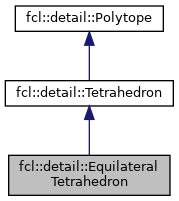
Public Member Functions | |
| EquilateralTetrahedron (ccd_real_t bottom_center_x=0, ccd_real_t bottom_center_y=0, ccd_real_t bottom_center_z=0, ccd_real_t edge_length=1) | |
 Public Member Functions inherited from fcl::detail::Tetrahedron Public Member Functions inherited from fcl::detail::Tetrahedron | |
| Tetrahedron (const std::array< fcl::Vector3< ccd_real_t >, 4 > &vertices) | |
 Public Member Functions inherited from fcl::detail::Polytope Public Member Functions inherited from fcl::detail::Polytope | |
| ccd_pt_edge_t & | e (int i) |
| const ccd_pt_edge_t & | e (int i) const |
| ccd_pt_face_t & | f (int i) |
| const ccd_pt_face_t & | f (int i) const |
| Polytope () | |
| ccd_pt_t & | polytope () |
| const ccd_pt_t & | polytope () const |
| ccd_pt_vertex_t & | v (int i) |
| const ccd_pt_vertex_t & | v (int i) const |
| ~Polytope () | |
Additional Inherited Members | |
 Protected Member Functions inherited from fcl::detail::Polytope Protected Member Functions inherited from fcl::detail::Polytope | |
| std::vector< ccd_pt_edge_t * > & | e () |
| std::vector< ccd_pt_face_t * > & | f () |
| std::vector< ccd_pt_vertex_t * > & | v () |
Detailed Description
Simple equilateral tetrahedron.
Geometrically, its edge lengths are the given length (default to unit length). Its "bottom" face is parallel with the z = 0 plane. It's default configuration places the bottom face on the z = 0 plane with the origin contained in the bottom face.
In representation, the edge ordering is arbitrary (i.e., an edge can be defined as (vᵢ, vⱼ) or (vⱼ, vᵢ). However, given an arbitrary definition of edges, the faces* have been defined to have a specific winding which causes e₀ × e₁ to point inwards or outwards for that face. This allows us to explicitly fully exercise the functionality for computing an outward normal.
- face 0: points outward
- face 1: points inward (requires flipping)
- face 2: points inward (requires flipping)
- face 3: points outward
All property accessors are mutable.
Definition at line 183 of file test_gjk_libccd-inl_epa.cpp.
Constructor & Destructor Documentation
◆ EquilateralTetrahedron()
|
inline |
Definition at line 185 of file test_gjk_libccd-inl_epa.cpp.
The documentation for this class was generated from the following file: